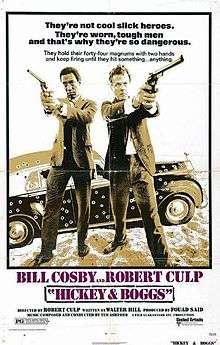Hickey & Boggs
| Hickey & Boggs | |
|---|---|
 Theatrical release poster | |
| Directed by | Robert Culp |
| Produced by | Fouad Said |
| Written by | Walter Hill |
| Starring | |
| Music by | Ted Ashford |
| Cinematography | Bill Butler |
| Edited by | David Berlatsky |
Production company |
Film Guarantors |
| Distributed by | United Artists |
Release dates |
|
Running time | 111 minutes |
| Country | United States |
| Language | English |
| Budget | $1 million[1] |
Hickey & Boggs is a 1972 neo-noir detective movie written by Walter Hill and directed by Robert Culp.
Plot
Culp and Cosby play weary, hard-luck private eyes Al Hickey and Frank Boggs hired to find a missing woman. Their enquiries bring death to almost everyone around them, culminating in a violent and downbeat conclusion.
Cast
- Bill Cosby as Al Hickey
- Robert Culp as Frank Boggs
- Ta-Ronce Allen as Nyona's Daughter
- Rosalind Cash as Nyona
- Lou Frizzell as Lawyer
- Isabel Sanford as Nyona's Mother
- Sheila Sullivan as Edith Boggs
- Robert Mandan as Mr. Brill
- Michael Moriarty as Ballard
- Vincent Gardenia as Papadakis
- Ed Lauter as Ted
- James Woods as Lt. Wyatt
Production
The script was an original of Walter Hill's who sold it to John Calley of Warner Bros. He sent it to Bill Cosby who agreed to star in the film if Bob Culp would direct. Culp agreed and the film was greenlit. However Culp and Calley disagreed over the budget - originally put at $2.2 million - so Calley sold the script to Culp, who tried to raise the money himself. The budget was revised to $1 million; Fouad Said agreed to provide half the money; the other half came from Film Guarantors, a film financing arm of Taft Broadcasting.[1]
Culp then rewrote Hill's script.[1]
Reception
Walter Hill later said he felt the film "had some nice moments, but it was cast much differently than it was written. I wasn't too excited about it."[2]
Critical response
When the film was released, the staff at Variety magazine questioned the film's screenplay, writing, "Culp makes his directorial bow and Fouad Said, who started in the industry as cameraman on I Spy series, debuts as a producer. Latter should have paid more attention to story line of the Walter Hill screenplay, which suffers through audience never being entirely certain as to the identity of some of the characters...Somehow, the femme is connected with missing loot but audience is never let in on secret."[3]
In the same vein, The New York Times also panned the screenplay, writing, "...while Robert Culp, who is also making his directorial debut with this caper, shows a flair for action and eye-catching composition in sordid and serene views of Los Angeles where all the shooting takes place, Hickey and Boggs is not involved in a story or with characters really worthy of a full theatrical treatment. Let's say, that Walter Hill, a newcomer to the screen, has written a script that's long on complexity and short on character definition..."[4]
More recently, critic Glenn Erickson made the case that the film was a bit dark for its time, writing, "There's plenty of violence and a dandy concluding shootout on a beach, but Hickey & Boggs was probably just too much of a downer to appeal to wide audiences. Action pictures of the time tended to be broader fantasies with humor and a lighter touch; heavy-duty cop shows like Badge 373 and The Friends of Eddie Coyle passed quietly. There's a scene in the picture where Hickey suffers a blow to his family and his whole life goes sour. From that point on there's little hope of anything pleasant happening. By the time of the final showdown our heroes seem to be going through the motions propelled only by existential inertia.[5]
See also
References
- 1 2 3 Cosby and Culp Together Again: Cosby, Culp Team Up Again POICCARD, MICHEL. Los Angeles Times (1923-Current File) [Los Angeles, Calif] 03 Oct 1971: r1.
- ↑ "Hard Riding", Greco, Mike, Film Comment 16.3 (May/Jun 1980): 13-19,80.
- ↑ Variety, film review, September 20, 1972. Last accessed: February 23, 2011.
- ↑ Weiler, A. H. The New York Times, film review, "Hickey and Boggs, a Tale of Chasing and Carnage," September 21, 1972. Last accessed: February 23, 2011.
- ↑ Erickson, Glenn. DVD Savant, film/DVD review, May 22, 2004. Last accessed: February 23, 2011.
External links
- Hickey & Boggs at the Internet Movie Database
- Hickey & Boggs at Rotten Tomatoes
- Hickey & Boggs short film clip on YouTube